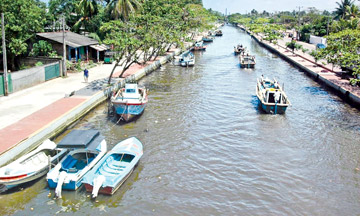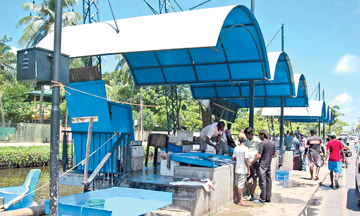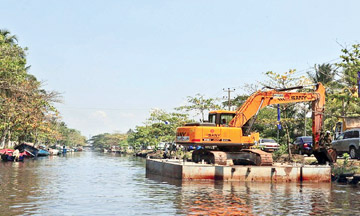|
Hamilton Canal - a major tourist attraction :
A source of sustainable livelihood
By Shirajiv Sirimane
Sri Lanka will soon add its second highway from Colombo to Katunayake
to its expressway network. The island has also signed a deal for its
second coal power project.
 |
| The Hamilton
Canal |
 |
Economic
Development Minister Basil Rajapaksa inspects the progress of
the Hamilton Canal Development Project in the company of
Japanese Ambassador Nobuhito Hobo |
 |
| The fish
market near the Hamilton Canal |

Work on the canal under way |
In addition, two international harbours - in Colombo and Hambantota -
enhance the country's maritime map while hydro power and several other
mega development projects have got off the ground all over the country,
changing its skyline.
On par with this mega development, the city beautification process
too is being implemented, also helping reduce flooding in the city.
About three decades ago, Malaysia was starving for investor attention
and was lagging behind in this area. The country's then President
Mahathir Mohamed, together with international road building companies
such as AVIS, started building a highway network which made the country
'smaller' and helped attract a host of international investors, leading
to the East Asian country being elevated to the status of a developed
nation.
Sri Lanka too seems to have taken a leaf from Malaysia, assigning
priority to the development of roads and highways. Railway lines are
being extended to the countryside after almost a century while abandoned
lines are being re-laid.
Many European countries make use of rivers for transport and
pleasure. The Nile is one such route heavily patronised by cruise lines.
During the colonial era, the Hamilton Canal was a preferred mode of
transport. Sadly, it had remained abandoned for nearly five decades in
modern history. However, realising the importance of this canal, the
Ministry of Economic Development under the watchful eyes of Economic
Development Minister Basil Rajapaksa, restored this historic canal and
today it can be easily mistaken for an area in Europe.
While being a major tourist attraction, it has now become a source of
sustainable livelihood for many people in the vicinity while an
unprecedented number of foreign and local tourists visit the Hamilton
Canal since it was developed.
Public use
The newly-developed canal was opened for public use on August 2 after
being developed in an environment-friendly manner under Minister
Rajapaksa's guidance. Until then, it had remained a highly polluted
waterway and a source of ill-health for decades. Today, nearly 8,000
people visit the canal area on weekends and it has become a major
attraction for foreign tourists, according to a Western Province Tourism
Ministry spokesman.
The Moratuwa University's Town Planning Studies section prepared the
Hamilton Canal development plan which was implemented by the Economic
Development Ministry. Under the first stage of the plan, eight
kilometres from the Negombo Lagoon to the Dandugum Oya river delta was
developed.
Under the second stage, a distance of 11 km is scheduled to be
developed. A part of the second phase - an extent of three km from
Hekiththa on the Kelani River in the Wattala Pradeshiya Sabha area to
Elakanda - has already been completed.
The Hamilton Canal project was launched with the objective of
developing the Negombo Tourism Zone. In connection with this, steps have
been taken to protect the rich biodiversity of the area, thus protecting
different species of fish, flora and fauna in and around the canal.
The development of the canal project covers a distance of 22
kilometres, from Ma Oya to the mouth of the Kelani River as a part of a
plan drawn up by the Moratuwa University to develop the Negombo tourism
region. Under this project, a handrail bridge to Hekiththa and jogging
tracks have been built while five bridges have been repaired and
renovated. Trees have been planted on either side of the canal, seats
have been constructed and 50 solar-powered lamps have been installed on
the banks.
Also, a two kilometre extent of the road which runs parallel to the
canal has been concreted and the boatman who earlier transported people
across the canal has been given a job as watcher of the bridge. The
canal has become a source of livelihood for nearly 100 families engaging
in small businesses for which the infrastructure has been built.
Japanese assistance
The Sri Lanka Lands Reclamation Corporation and Provincial Road
Development Authority carried out the program with Japanese Government
assistance.
In 1802, the British started constructing a new canal to the east of
the canal which had earlier been built by Sinhalese kings and the Dutch.
This was called Hamilton Canal and was meant to link the Dutch Canal by
a series of parallel canals designed to drain the Muturajawela basin.
However, what happened was the opposite as the high tide brought
salinity to the water, not only from the Negombo lagoon, but also from
the Kelani river.
In the 15th Century, during the reign of King Vira Parakramabahu
VIII, the Negombo lagoon served as the main seaport for trading in
cinnamon and other commodities. It is presently called the Dutch Canal
and links the Kelani river with the main sea port of Negombo lagoon to
the east of Muturajawela.
According to the GCEC environmental profile of the Muturajawela and
Negombo Lagoon (March 1991), it was this king who initiated the canal
project to facilitate access and transport of goods. The Dutch improved
upon it.
The canal in its present form was completed during the early British
period in 1802. That year, British Revenue and Commerce Agent Garvin
Hamilton started building a new canal (now named Hamilton) to the east
of the earlier Dutch Canal to link the latter with a series of parallel
canals.
The canal and its vicinity is of much environmental importance since
the area is home to different species of fish, birds and plants and is
rich in biodiversity, making it ideal for eco-tourism. In view of this,
embankments were built to protect the canal banks on either side of the
waterway that were beautified. |

